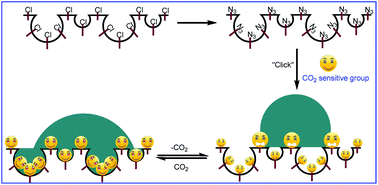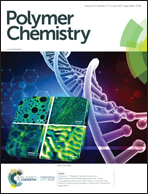CO2-Driven reversible wettability in a reactive hierarchically patterned bio-inspired honeycomb film†
Abstract
A unique triple patterned honeycomb film with CO2-driven reversible wettability between hydrophobicity and hydrophilicity is reported in this work. The honeycomb film is prepared by directed self-assembly in “Breath Figure” (BF) templating of a PolyStyrene-b-Poly(VinylBenzylChloride) PS-b-PVBC block copolymer under a mixed water/ethanol atmosphere. Three scales of hierarchy with micro- and nano-porosities, i.e. two levels of structuration formed by the BF process, lead to a bio-inspired morphology resembling the diatom exoskeleton, while the third level is induced by the directed diblock copolymer self-assembly between the pores. Reactive PVBC surface nano-patterns are post-clicked by a melamine derivative with tertiary amino groups to drive the CO2-switchable wettability. The presence of the triple structures remarkably increases the top surface structuration, resulting in an enhanced contact angle compared with normal honeycomb films. The combination of this unique clickable patterned platform and CO2-sensitive groups endows the film with a large change in the contact angle upon CO2 stimulation. Such a smart bio-inspired honeycomb film based on a biocompatible trigger shows high application potential in bioengineering.



 Please wait while we load your content...
Please wait while we load your content...